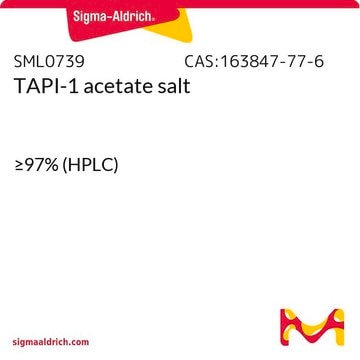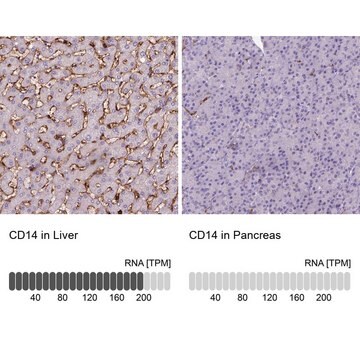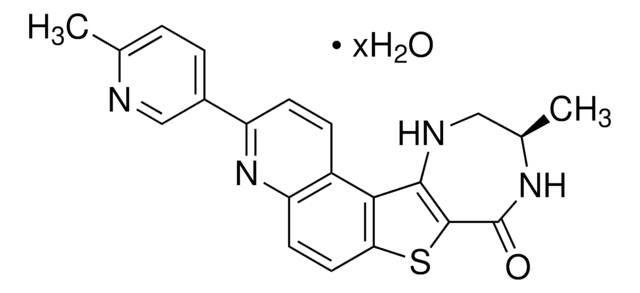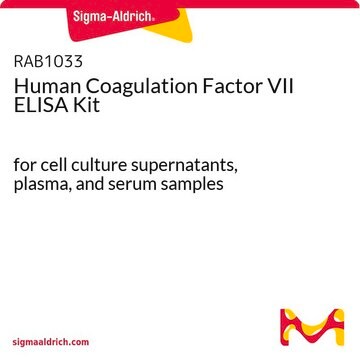추천 제품
생물학적 소스
rat
결합
unconjugated
항체 형태
purified immunoglobulin
항체 생산 유형
primary antibodies
클론
RCR-252, monoclonal
형태
buffered aqueous solution
분자량
antigen 49 kDa
종 반응성
human
기술
flow cytometry: 5-20 μg/mL using HUVEC cells
microarray: suitable
동형
IgG1
UniProt 수납 번호
배송 상태
dry ice
저장 온도
−20°C
타겟 번역 후 변형
unmodified
유전자 정보
human ... PROCR(10544)
일반 설명
Anti-endothelial cell protein C receptor antibody, rat monoclonal (EPCR) (rat IgG1 isotype) is derived from the RCR-252 hybridoma produced by the fusion of mouse SP2/0 myeloma cells and cells isolated from the superficial inguinal lymph nodes from Wister rats immunized with human EPCR-positive RE-1 cells. Endothelial protein C receptor (EPCR), also known as activated protein C receptor (APC receptor) is a protein encoded by the PROCR gene in humans. It is predominantly expressed in endothelial. The EPCR is also expressed in small vessels such as capillaries of the alveolar wall in the lung. EPCR is a member of the CD1/major histocompatibility complex superfamily.
면역원
human EPCR-positive RE-1 cells.
애플리케이션
Anti-endothelial cell protein C receptor antibody, rat monoclonal has been used in flow cytometry (FACS analysis) and in blocking the binding of the antigen presenting cell (APC) ligand to the EPCR.
생화학적/생리학적 작용
Endothelial protein C receptor (EPCR) is involved in regulation of the cytoprotective and anticoagulant pathways of protein C. EPCR plays an important role in regulating the inflammatory response. It is also identified as an endothelial receptor for specific P. falciparum erythrocyte membrane protein 1 (PfEMP1) subtypes. EPCR is associated with an increased risk of venous thromboembolism (VTE).
물리적 형태
Solution in 0.01 M phosphate buffered saline, pH 7.4, containing 15 mM sodium azide.
면책조항
Unless otherwise stated in our catalog or other company documentation accompanying the product(s), our products are intended for research use only and are not to be used for any other purpose, which includes but is not limited to, unauthorized commercial uses, in vitro diagnostic uses, ex vivo or in vivo therapeutic uses or any type of consumption or application to humans or animals.
적합한 제품을 찾을 수 없으신가요?
당사의 제품 선택기 도구.을(를) 시도해 보세요.
Storage Class Code
10 - Combustible liquids
WGK
WGK 2
Flash Point (°F)
Not applicable
Flash Point (°C)
Not applicable
개인 보호 장비
Eyeshields, Gloves, multi-purpose combination respirator cartridge (US)
시험 성적서(COA)
제품의 로트/배치 번호를 입력하여 시험 성적서(COA)을 검색하십시오. 로트 및 배치 번호는 제품 라벨에 있는 ‘로트’ 또는 ‘배치’라는 용어 뒤에서 찾을 수 있습니다.
Mark R Gillrie et al.
Cellular microbiology, 17(12), 1883-1899 (2015-06-30)
Plasmodium falciparum-infected erythrocytes (IRBC) expressing the domain cassettes (DC) 8 and 13 of the cytoadherent ligand P. falciparum erythrocyte membrane protein 1 adhere to the endothelial protein C receptor (EPCR). By interfering with EPCR anti-coagulant and pro-endothelial barrier functions, IRBC adhesion
Marion Avril et al.
mBio, 7(4) (2016-07-14)
Intercellular adhesion molecule 1 (ICAM-1) and the endothelial protein C receptor (EPCR) are candidate receptors for the deadly complication cerebral malaria. However, it remains unclear if Plasmodium falciparum parasites with dual binding specificity are involved in cytoadhesion or different parasite
The endothelial cell protein C receptor (EPCR) functions as a primary receptor for protein C activation on endothelial cells in arteries, veins, and capillaries
Ye X, et al.
Biochemical and biophysical research communications, 259(3), 671-677 (1999)
Alice G Vassiliou et al.
Intensive care medicine, 39(10), 1752-1759 (2013-07-25)
Endothelial protein C receptor (EPCR) is expressed mainly in endothelial cells and is involved in regulation of the cytoprotective and anticoagulant pathways of protein C. We assessed whether haplotypes in the EPCR gene modify the risk of severe sepsis and/or
Maria Bernabeu et al.
mBio, 10(3) (2019-05-30)
Cerebral malaria is a severe neurological complication associated with sequestration of Plasmodium falciparum-infected erythrocytes (IE) in the brain microvasculature, but the specific binding interactions remain under debate. Here, we have generated an engineered three-dimensional (3D) human brain endothelial microvessel model
자사의 과학자팀은 생명 과학, 재료 과학, 화학 합성, 크로마토그래피, 분석 및 기타 많은 영역을 포함한 모든 과학 분야에 경험이 있습니다..
고객지원팀으로 연락바랍니다.








